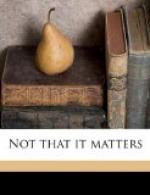One of the author’s weaknesses is a certain carelessness in the naming of his characters. For instance, no fewer than two hundred and forty-one of them are called Smith. True, he endeavours to distinguish between them by giving them such different Christian names as John, Henry, Charles, and so forth, but the result is bound to be confusing. Sometimes, indeed, he does not even bother to distinguish between their Christian names. Thus we have three Henry Smiths, who appear to have mixed themselves up even in the author’s mind. He tells us that Colonel Henry’s chief recreation is “the study of the things around him,” but it sounds much more like that of the Reverend Henry, whose opportunities in the pulpit would be considerably greater. It is the same with the Thomsons, the Williamses and others. When once he hits upon one of these popular names, he is carried away for several pages, and insists on calling everybody Thomson. But occasionally he has an inspiration. Temistocle Zammit is a good name, though the humour of calling a famous musician Zimbalist is perhaps a little too obvious.
In conclusion, one can say that while our author’s merits are many, his faults are of no great moment. Certainly he handles his love-scenes badly. Many of his characters are married but he tells us little of the early scenes of courtship, and says nothing of any previous engagements which were afterwards broken off. Also, he is apparently incapable of describing a child, unless it is the offspring of titled persons and will itself succeed to the title; even then he prefers to dismiss it in a parenthesis. But as a picture of the present-day Englishman his novel can hardly be surpassed. He is not a writer who is only at home with one class. He can describe the utterly unknown and unimportant with as much gusto as he describes the genius or the old nobility. True, he overcrowds his canvas, but one must recognize this as his method. It is so that he expresses himself best; just as one painter can express himself best in a rendering of the whole Town Council of Slappenham, while another only requires a single haddock on a plate.
His future will be watched with interest. He hints in his introduction that he has another volume in preparation, in which he will introduce to us several entirely new C.B.E.’s, besides carrying on the histories (in the familiar manner of our modern novelists) of many of those with whom we have already made friends. Who’s Who, 1920, it is to be called, and I, for one, shall look out for it with the utmost eagerness.




